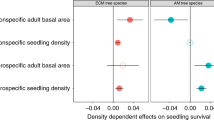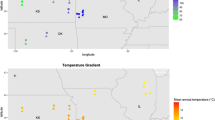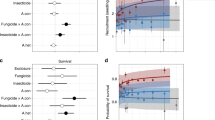Abstract
The Janzen–Connell hypothesis1,2 proposes that host-specific, distance- and/or density-dependent predators and herbivores maintain high tree diversity in tropical forests. Negative feedback between plant and soil communities could be a more effective mechanism promoting species coexistence because soil pathogens can increase rapidly in the presence of their host3, causing conditions unfavourable for local conspecific recruitment4,5,6. Here we show that a soil pathogen leads to patterns of seedling mortality in a temperate tree (Prunus serotina) as predicted by the Janzen–Connell hypothesis. In the field, the mean distance to parent of seedling cohorts shifted away from maternal trees over a period of 3 years. Seedlings were grown in soil collected 0–5 m or 25–30 m from Prunus trees. Sterilization of soil collected beneath trees improved seedling survival relative to unsterilized soil, whereas sterilization of distant soil did not affect survival. Pythium spp., isolated from roots of dying seedlings and used to inoculate healthy seedlings, decreased survival by 65% relative to controls. Our results provide the most complete evidence that native pathogens influence tree distributions, as predicted by the Janzen–Connell hypothesis, and suggest that similar ecological mechanisms operate in tropical and temperate forests.
This is a preview of subscription content, access via your institution
Access options
Subscribe to this journal
Receive 51 print issues and online access
$199.00 per year
only $3.90 per issue
Buy this article
- Purchase on Springer Link
- Instant access to full article PDF
Prices may be subject to local taxes which are calculated during checkout




Similar content being viewed by others
References
Janzen, D. H. Herbivores and the number of tree species in tropical forests. Am. Nat. 104, 501–508 ( 1970).
Connell, J. H. in Dynamics in Populations (eds den Boer, P. J. & Gradwell, G. R.) 298–312 (Center for Agricultural Publishing and Documentation, Wageningen, 1971).
Burdon, J. J. Diseases and Plant Population Biology (Cambridge Univ. Press, Cambridge, 1987).
Florence, R. G. Decline of old-growth forests in relation to some soil microbiological processes. Ecology 46, 52–64 (1965).
Bever, J. D., Westover, K. M. & Antonovics, J. Incorporating the soil community into plant population dynamics: the utility of the feedback approach. J. Ecol. 85, 561–573 (1997).
Mills, K. E. & Bever, J. D. Maintenance of diversity within plant communities: soil pathogens as agents of negative feedback. Ecology 79, 1595–1601 ( 1998).
Hubbell, S. P. Seed predation and the coexistence of tree species in tropical forests. Oikos 35, 214–229 ( 1980).
Augspurger, C. K. Offspring recruitment around tropical trees: changes in cohort distance with time. Oikos 40, 189–196 (1983).
Augspurger, C. K. & Kelly, C. K. Pathogen mortality of tropical tree seedlings: experimental studies of the effects of dispersal distance, seedling density, and light conditions. Oecologia 61, 211–217 (1984).
Clark, D. A. & Clark, D. B. Spacing dynamics of a tropical rain forest tree: evaluation of the Janzen–Connell model. Am. Nat. 124, 769–788 ( 1984).
Connell, J. H., Tracey, J. G. & Webb, L. J. Compensatory recruitment, growth and mortality as factors maintaining rain forest tree diversity. Ecol. Monogr. 54, 141–164 (1984).
Becker, P., Lee, L. W., Rothman, E. D. & Hamilton, W. D. Seed predation and the coexistence of tree species: Hubbell's models revisited. Oikos 44, 382–390 (1985).
Condit, R., Hubbell, S. P. & Foster, R. B. Recruitment of conspecific adults and the maintenance of tree and shrub diversity in a neotropical forest. Am. Nat. 140, 261–286 (1992).
Gilbert, G. S., Hubbell, S. P. & Foster, R. B. Density and distance to adult effects of a canker disease of trees in a moist tropical forest. Oecologia 98, 100–108 (1994).
Notman, E., Gorchov, D. L. & Cornejo, F. Effect of distance, aggregation, and habitat on levels of seed predation for two mammal-dispersed neotropical rain forest tree species. Oecologia 106, 221–227 (1996).
Wills, C., Condit, R., Foster, R. B. & Hubbell, S. P. Strong density- and diversity-related effects help to maintain species diversity in a neotropical forest. Proc. Natl Acad. Sci. 94, 1252–1257 (1997).
Schupp, E. W. The Janzen–Connell model for tropical tree diversity: population implications and the importance of spatial scale. Am. Nat. 140, 526–530 (1992).
Burkey, T. V. Tropical tree species diversity: A test of the Janzen–Connell model. Oecologia 97, 533–540 (1994).
Cintra, R. A test of the Janzen–Connell model with two common tree species in Amazonian forest. J. Trop. Ecol. 13, 641– 658 (1997).
Burdon, J. J. & Chilvers, G. A. Host density as a factor in plant disease ecology. Annu. Rev. Phytopathol. 20, 143–166 (1982).
Fox, J. F. Alternation and coexistence of tree species. Am. Nat. 111, 69–89 (1977).
Woods, K. D. Reciprocal replacement and the maintenance of codominance in a beech maple forest. Oikos 33, 31–39 (1979).
Van der Putten, W. H. & Peters, B. A. M. How soil-borne pathogens may affect plant competition. Ecology 78, 1785–1795 (1997).
Van der Putten, W. H., Van Dijk, C. & Peters, B. A. M. Plant-specific soil-borne diseases contribute to succession in foredune vegetation. Nature 362, 53–56 (1993).
Bever, J. D. Feedback between plants and their soil communities in an old field community. Ecology 75, 1965–1977 (1994).
Chen, W., Schneider, R. W. & Hoy, J. W. Taxonomic and phylgenetic analyses of ten Pythium species using isozyme polymorphisms. Phytopathology 82, 1234–1244 (1992).
Carlisle, M. J. & Watkinson, S. C. The Fungi (Academic, Harcourt Brace & Co., New York, 1994 ).
Barone, J. A. Host-specificity of folivorous insects in a moist tropical forest. J. Animal Ecol. 67, 400–409 (1998).
May, R. M. How many species are there on Earth? Science 241, 1441–1449 (1988).
Acknowledgements
We thank C. Augspurger, G. Gilbert, J. Holah, P. Kover, C. Lively and J. Price for critical review of the manuscript. We also thank R. Wagner for assistance with fungal isolation and identification, and J. Berg, M. Hallinan, M. Hardesty, T. Levitt, A. Overgaard, M. Selby, L. Somers and members of the Clay lab for field assistance. This work was supported by grants to A.P. from the Indiana Academy of Sciences and Indiana University.
Author information
Authors and Affiliations
Rights and permissions
About this article
Cite this article
Packer, A., Clay, K. Soil pathogens and spatial patterns of seedling mortality in a temperate tree. Nature 404, 278–281 (2000). https://doi.org/10.1038/35005072
Received:
Accepted:
Issue Date:
DOI: https://doi.org/10.1038/35005072
This article is cited by
-
Japanese white oak seedlings killed by Phytophthora castaneae: a potential source of chestnut trunk rot
Journal of General Plant Pathology (2024)
-
Rapid differentiation of soil and root microbiomes in response to plant composition and biodiversity in the field
ISME Communications (2023)
-
Modelling how negative plant–soil feedbacks across life stages affect the spatial patterning of trees
Scientific Reports (2023)
-
Plant-soil feedbacks persist following tree death, reducing survival and growth of Populus tremuloides seedlings
Plant and Soil (2023)
-
Plant-soil feedback: incorporating untested influential drivers and reconciling terminology
Plant and Soil (2023)
Comments
By submitting a comment you agree to abide by our Terms and Community Guidelines. If you find something abusive or that does not comply with our terms or guidelines please flag it as inappropriate.



